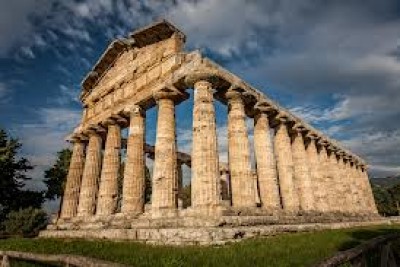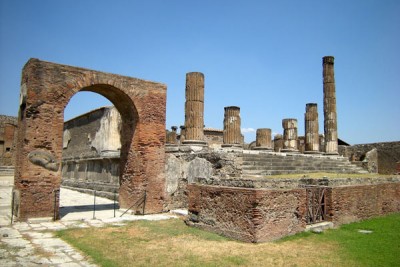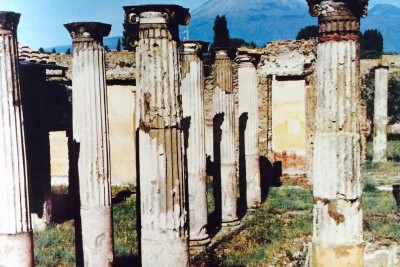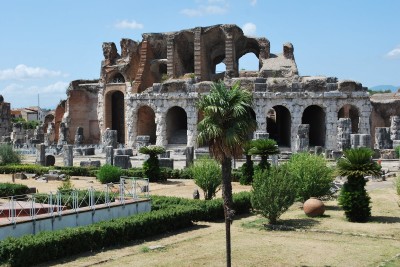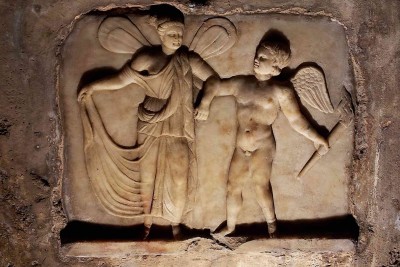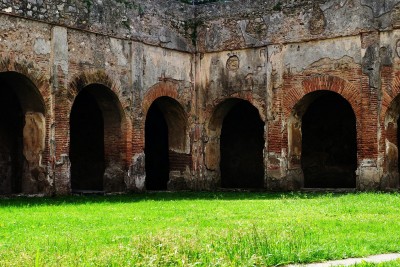Paestum and the Homes of the Gods
The three temples in this complex are among the best preserved and most beautiful in the world



When something is perfect, we tend to neglect to ask about its evolution, delighting rather in what is present, as if it had risen from the ground by magic. In this regard we are probably still under the influence of an ancient mythological sentiment. Looking at a Greek temple like the one at Paestum… we feel almost as if a god, playing one morning, had built his residence out of these enormous blocks.” Friedrich Wilhelm Nietzsche. “Human, Too Human. A Book for Free Spirits”
Paestum is one of the most important archaeological sites in Italy. The remains of its Doric temples, which are perhaps second only to the Parthenon, rise within the city walls, give the visitor a sense of majesty. They are particularly impressive at sunset and dusk.
The town of Paestum was founded towards the end of the 7th century B.C. by Greek colonists from Sybaris, and was then Poseidonia (Neptune City). It soon became a major agricultural and maritime center that traded with the Etruscans and survived longer than Sybaris itself, which was destroyed in 510 B.C.
Around 400 B.C. Poseidonia was conquered by the Lucans, who changed the name in Paistom or Paistos.
In 273, the Romans moved in and changed the name of the town to Paestum.
They built the baths, the Forum, the Italic Temple and the Amphitheater.
Malaria from rising groundwater due to deforestation of the area gradually pushed the population towards the mountains, causing the decline of the city.
In the 11h century, Roger the Norman partly stripped the temples of its marble, while Robert the Guiscard moved the sculptures to the Cathedral of Salerno.
The ruins were forgotten in the woods and swamps until the mid-18th century, when the opening of a road led to their rediscovery.
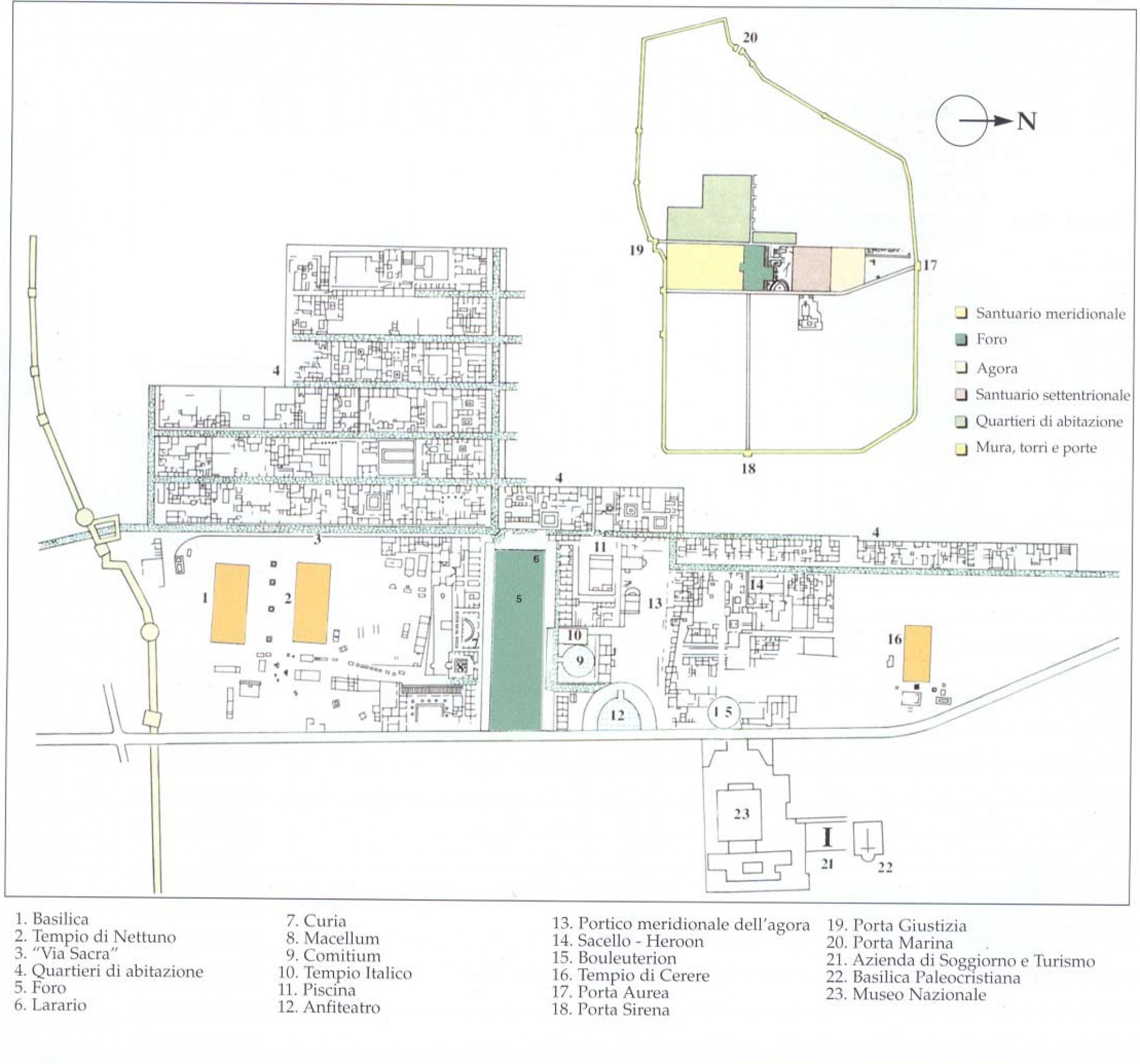
The three majestic Doric temples in this complex are among the best-preserved ancient Greek temples in the world and, wrapped in a romantic scenery dotted with cypress trees and oleanders, Paestum still mantains a certain melancholy atmosphere of the ancient city.
The Basilica or Temple of Hera (#1 in the map), is the oldest temple in Paestum.
 It was built shortly after the mid-6th century BC and dedicated to the goddess Hera. In front, there is an important and well-preserved altar for sacrifices.
It was built shortly after the mid-6th century BC and dedicated to the goddess Hera. In front, there is an important and well-preserved altar for sacrifices.
To the right of the Basilica, is the Tempio di Nettuno (#2), or Temple of Neptune or Poseidon, the largest and best preserved of the temples of Paestum.

It was built around 450 BC. The material used in the construction was local travertine, which was softer than that of the other buildings and over time took on a warm golden patina, which seems to turn itself on or off depending on the intensity of the light.
Its great and mighty structure and perfect proportions, together with some other aspects (slightly curved horizontal lines, elliptical rather than circular columns), create an impression of unshakable firmness and elegance, making this building the most perfect example of Doric architecture both in Italy and Greece.
The material found in the votive offerings (thousands of terracotta figurines representing the goddess Hera , locally manufactured vases of the Lucan age, wedding vases, gems, coins, etc.) helped determine that the temple was dedicated to Argive Hera, goddess of motherhood and fertility.
In front of the temple are the remains of two sacrificial altars: the closest and smallest was erected in the third century BC by the Romans to replace the original one.
Following a path that starts from the north front of the Temple and retains traces of Roman paving, one arrives at the Macellum (#8).

This is the ancient Roman indoor market that normally sat alongside the forum and basilica and where the market was held.
Next to the Macellum is the Curia (#7), or court, iwhere public or religious issues were discussed and decisions made.

In ancient Rome, the entire populace was divided into thirty curiae, which met in order to confirm the election of magistrates, witness the installation of priests, the making of wills, and adoptions.
Further north is the Forum (#5).

With the extensive foundations of various public and private buildings, it was built after the Romans settled in Paestum (in 273 B.C.) in what was the agora of the Greek city.
Further down there is the Tempio Italico (#10), or Italic Temple, designed around 273 BC and completed not long after.

In all likelihood it was the Capitolium, dedicated to Jupiter, Juno and Minerva. It stands on a high podium, preceded by a wide staircase, in front of which there is a rectangular altar made up of 6 columns (later reduced to 4) on the front, and 8 on the long sides.
Just next to the Italic Temple is the Piscina (#11), or swimming pool.

To the east of the Temple is a small Anfiteatro, (#12) or Roman Amphiteater.

Only the southern half of theater is still visible. In 1930, a road was built across the site, burying the northern half. It is said by local inhabitants that the civil engineer responsible was tried, convicted and received a prison sentence for what was described as wanton destruction of a historic site.
Further north is the Bouleuterion (#15).

This building housed the council of citizens, boule, a basic institution of the city-state (polis) made up of the citizens' representatives who assembled in order to confer and decide about public affairs. The word bouleuterion is composed from Greek boule (council) and the suffix -terion (place for doing something).
Along the side of the Bouleuterion, from south to north, runs the Via Sacra (#3), or Sacred Way, the road used for religious procession that was rediscovered in 1907. The road was paved with large limestone blocks that still show the indentations left by the wagon wheels.
To the west of the Via Sacra is the large area of the Quartieri di abitazione (#4), or Living Quarters.

Continuing along the Sacred Way to the north and then turning right, the Tempio di Cerere (#16), or Temple of Ceres, which can be seen on a plateau bordered by pine trees.
 Ceres was the goddess of agriculture, . However, the numerous clay figurines and heads of the goddess Athena and a fragment of a vase with her name that were discovered indicates that the temple was dedicated to her.
Ceres was the goddess of agriculture, . However, the numerous clay figurines and heads of the goddess Athena and a fragment of a vase with her name that were discovered indicates that the temple was dedicated to her.
It is the third of the great Doric temples of Paestum, built at the end of the 6th century BC. The temple with a porch of 34 fluted columns (6 on the short sides and 13 on the long sides), was transformed into a church during the High Middle Ages. The excavations, which freed the temple from the rest of a medieval village that was built next to it, brought to light a sacrificial altar and numerous remains of Greek buildings, some older than the temple.
To the west of the Temple of Ceres is the Porta Sirena (#18).

The Museo Archeologico di Paestum (#23), or Archeological Museum of Paestum, found on the way out of the walled city, includes materials found in the city, the necropolis nearby and the sanctuary of Hera at the mouth of the Sele River.

The wall that surround the city are of Greek origin, but was strengthened and rebuilt by the Romans and Lucans. It form a powerful pentagonal circuit made of large limestone blocks, reinforced by round or square towers, and 4 large doors.
To reach the Torre di Paestum (not in the map), or Tower of Paestum, a truncated cone-shaped watchtower similar to those built on the Amalfi Coast, begin from the western end of the southern boundary of the wall, continue along the road that leads to the Marina of Paestum for about a mile.

The interior of the tower is divided in two: the top can be accessed through an external staircase with a ladder that leads to the terrace with a beautiful view of the Gulf of Salerno. On a nice day, one can see Capri. Atrani , Amalfi and even Ravello up high.
For printing our Paestum Guide (facing pages) you can download the PDF by clicking HERE
For offline reading on your smartphone or tablet, you can download the PDF of our Paestum Guide (single page) by clicking HERE
If you have an Android OS, you will find it in your Download app.
If you have an iPhone or an iPad, open and save it in iBook (free app).
Museo Archeologici di Paestum Via Magna Grecia, Capaccio Tel: (+39) 082 8811023 Hours: 9 AM until an hour before sunset
A full day is sufficient to explore the ruins and museum unless you are a serious student of archaeology.
Take a virtual tour of the archeological area in Paestum with Google Maps
Amalfi Coasting also recommends:
these websites:
and these videos:

